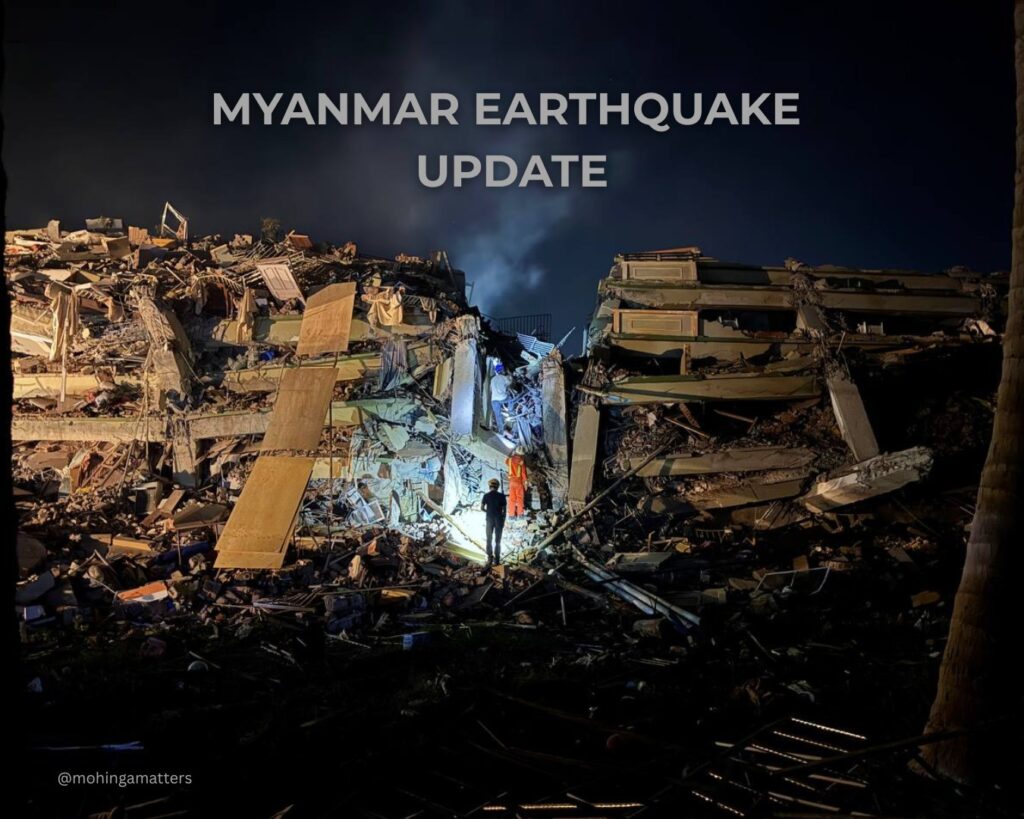
Updated 31 March 2025
The crucial 72-hour window—the period when those trapped under rubble have the highest chance of survival—has now passed. In Mandalay, some evacuation teams shifted their focus after finding no signs of life at certain sites. A significant portion of the rescue efforts was concentrated on the Sky Villa condominium due to its size and the number of residents inside. But after 72 hours, only a handful were saved, while dozens remained buried. In many areas, people have started to fear that it’s now more about recovering bodies than rescuing survivors, except for the few who got incredibly lucky.
One of the most heartbreaking incidents in Mandalay was the collapse of a building housing “Simbolo,” a tech startup founded by young, brilliant minds. Its founder, Phyo Thu Htet, perished alongside his parents and staff—on his own birthday. His last words on social media showed his dedication to the growth and longevity of his startup. In a time when so many young talents have been forced to flee Myanmar, it’s devastating to lose yet another one. If there’s a way to honor his last wish, it would be to support the continuation of his work.
Another reported tragedy in Mandalay was when a religious building collapsed during an exam, killing up to 50 monks. In Pyawbwe Township, a KBZ bank branch crumbled, trapping and killing all 40 people inside. Over 50 mosques in Sagaing, Mandalay, and Yamethin were destroyed, with more than 300 deaths reported. In Sagaing alone, nearly every house sustained damage. In some areas, the bodies of the deceased have started to decompose, but recovery efforts remain slow due to a severe lack of manpower and resources. Today, the most urgently needed supplies are body bags, food, and clean water.
Despite the scale of the disaster, the regime has rejected assistance from Taiwan’s rescue team, which had been awaiting clearance to enter Myanmar. While teams from China, Russia, Singapore, India, and Malaysia have arrived, there is no justification for turning away additional help. And it’s not just foreign aid being blocked—the junta has also denied entry to international media, citing a supposed lack of accommodation and electricity. But the truth is clear: they don’t want the world to witness how badly they are failing the country.
Meanwhile, local volunteer groups are facing arrests and harassment. Many trying to enter Sagaing have been stopped under the pretext that resistance forces might be using the disaster as cover. Volunteer-led evacuation efforts have been repeatedly obstructed for lacking “official permission.” Once again, the regime is doing everything in its power to keep the people of Myanmar from receiving the help they desperately need, all to maintain its grip on power.
And still, the airstrikes continue. In addition to previous attacks, aerial bombings were reported in Pale Township (Sagaing), Hpruso Township (Karenni), and Salin Township (Sagaing). At the very least, international media is now linking these attacks to the ongoing earthquake disaster. Outlets like The New York Times and Thai media have started covering both in the same reports. We are grateful for this and urge continued coverage.
As the earth shakes and people struggle to survive, they are still being bombed from above. There is no lower point of human cruelty than this. Min Aung Hlaing may be trying to use this disaster to gain international legitimacy, but we believe this will only bring him closer to his downfall.
Updated 30 March 2025
Day three, and people are still trapped under the ruins. According to DVB TV News, the death toll has surpassed 2,900 and continues to rise, with Mandalay accounting for 70% of the casualties. Aftershocks have been frequent, further weakening an already fragile evacuation system and endangering unstable buildings. It is heartbreaking to see civilians leading the rescue efforts, pulling people from the ruins with their bare hands in some places.
International rescue teams have arrived, but most are being sent to Naypyidaw and Mandalay, where the most visible destruction is. However, in other regions—especially Sagaing—hundreds of small civilian homes have collapsed, and they, too, are in urgent need of assistance.
Meanwhile, Min Aung Hlaing appears to be prioritizing the reconstruction of his capital and military assets. State media broadcasted his phone call with the Indian prime minister, reporting on the crisis as if he were using this disaster as an opportunity to gain international legitimacy. The regime has also announced its “willingness” to cooperate with all organizations in relief efforts.
In response, the National Unity Government (NUG) has declared a two-week ceasefire across the country. This is believed to counter the regime’s claims that revolutionary forces are attacking evacuation teams in certain areas. Additionally, the NUG has pledged US$1 million for evacuation efforts and offered manpower, including CDM staff, to mobilize in junta-controlled regions—on the condition that they will not be arrested. Trusting the regime to keep its word is, of course, another matter. The Myanmar National Democratic Alliance Army (MNDAA) has also extended its assistance, but so far, no opposition forces have been seen coordinating rescue operations on the ground.
Some political analysts have suggested that this could be a moment to push for peace and reconciliation. But it is not the resistance forces that need convincing first. The regime has continued its attacks, launching airstrikes and artillery shelling in Banmaw (Kachin State), Ponnagyun (Rakhine State), and Pauk (Magway Region). Even in the midst of a humanitarian crisis, Min Aung Hlaing and his regime remain relentless in their violence against civilians.
Right now, the most urgent priority is rescuing those still trapped under collapsed buildings, which requires heavy machinery and specialized equipment—something international teams are bringing in. In areas they cannot reach, civilians continue to dig through the debris with their bare hands. Where we can help is by providing food, water, and shelter for both displaced people and volunteers—until every last survivor is found.
Please connect with your local contacts and assist however you can. While Naypyidaw and Mandalay have media attention, Sagaing and other affected areas need urgent aid as well. And whatever support is given—whether funds or awareness—it must be sustained. Too often, donations and aid flood in at the beginning of a disaster but fade quickly. The rescue efforts will take weeks, and rebuilding will take years. The regime is neither prepared nor willing to take on that responsibility.
Thank you again for your continued support and prayers for the people of Myanmar.
Updated 29 March 2025
Another disaster has struck Myanmar—this time, in the form of a devastating earthquake. Experts have warned us time and again about the risks of natural disasters, yet we either failed to listen or had other priorities. Now, the unthinkable has happened.
Yesterday, a 7.7-magnitude earthquake hit, centered around the Sagaing Fault, leaving hundreds dead and thousands missing or injured. Mandalay, Naypyidaw and Sagaing are among the hardest-hit areas. The quake struck at 12:50 PM, right during lunchtime when families were gathered, which meant in some places, entire families were lost. Since it also coincided with prayer time for Muslims, many mosques—most of them decades old—suffered severe damage, leading to heavy casualties.
Right now, rescue operations are underway, mostly led by civilians, as the military regime is neither equipped nor willing enough to provide sufficient help. With many young people forced to flee due to the conscription law, Myanmar is missing a critical part of its workforce—those who would have been at the front lines of rescue efforts.
We know that under the previous NLD government, a helicopter and emergency funds were allocated for disaster response. But this time, no helicopters were deployed for evacuation—instead, reports suggest that the regime diverted those funds to its cronies. Meanwhile, helicopters are being used for military purposes—airstrikes were reported in Naungcho, Shan State, even in the aftermath of the earthquake.
With international aid now crucial, we urge the global community to be mindful of how assistance is handled. While engagement with the regime may be unavoidable in some cases, it is crucial to allocate aid wisely. There are independent organizations, civil groups, and resistance forces operating in junta-free areas that can conduct effective evacuation efforts. Please push for direct civilian-led aid wherever possible.
And if there is any way to halt airstrikes, even temporarily, during this disaster, please help us. It makes no sense that in one part of the country, people are being rescued, while in another, they are being bombed. At the very least, don’t let them inflict more harm while a major evacuation is underway.
Thank you all for reaching out and standing with us during this disaster.

